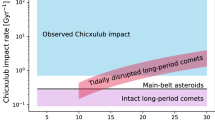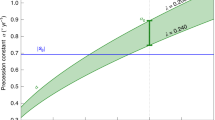Abstract
Cometary outgassing can produce torques that change the spin state of the cometary nucleus, which in turn influences the evolution and lifetime of the comet1,2. If these torques increase the rate of rotation to the extent that centripetal forces exceed the material strength of the nucleus, the comet can fragment3. Torques that slow down the rotation can cause the spin state to become unstable, but if the torques persist the nucleus can eventually reorient itself and the rotation rate can increase again4. Simulations predict that most comets go through a short phase of rapid changes in spin state, after which changes occur gradually over longer times5. Here we report observations of comet 41P/Tuttle–Giacobini–Kresák during its close approach to Earth (0.142 astronomical units, approximately 21 million kilometres, on 1 April 2017) that reveal a rapid decrease in rotation rate. Between March and May 2017, the apparent rotation period of the nucleus increased from 20 hours to more than 46 hours—a rate of change of more than an order of magnitude larger than has hitherto been measured. This phenomenon must have been caused by the gas emission from the comet aligning in such a way that it produced an anomalously strong torque that slowed the spin rate of the nucleus. The behaviour of comet 41P/Tuttle–Giacobini–Kresák suggests that it is in a distinct evolutionary state and that its rotation may be approaching the point of instability.
This is a preview of subscription content, access via your institution
Access options
Access Nature and 54 other Nature Portfolio journals
Get Nature+, our best-value online-access subscription
$29.99 / 30 days
cancel any time
Subscribe to this journal
Receive 51 print issues and online access
$199.00 per year
only $3.90 per issue
Buy this article
- Purchase on Springer Link
- Instant access to full article PDF
Prices may be subject to local taxes which are calculated during checkout




Similar content being viewed by others
References
Jewitt, D. Cometary rotation: an overview. Earth Moon Planets 79, 35–53 (1997)
Keller, H. U., Mottola, S., Skorov, Y. & Jorda, L. The changing rotation period of comet 67P/Churyumov–Gerasimenko controlled by its activity. Astron. Astrophys. 579, L5 (2015)
Davidsson, B. J. R. Tidal splitting and rotational breakup of solid biaxial ellipsoids. Icarus 149, 375–383 (2001)
Samarasinha, N. H., Mueller, B. E. A., Belton, M. J. S. & Jorda, L. in Comets II (eds Festou, M. et al.) 281–299 (Univ. Arizona Press, 2004)
Gutiérrez, P. J., Jorda, L., Ortiz, J. L. & Rodrigo, R. Long-term simulations of the rotational state of small irregular cometary nuclei. Astron. Astrophys. 406, 1123–1133 (2003)
Gehrels, N. et al. The Swift Gamma-Ray Burst mission. Astrophys. J. 611, 1005–1020 (2004)
Farnham, T. L., Schleicher, D. G. & A’Hearn, M. F. The HB narrowband comet filters: standard stars and calibrations. Icarus 147, 180–204 (2000)
A’Hearn, M. F. et al. Cyanogen jets in comet Halley. Nature 324, 649–651 (1986)
Schleicher, D. G. & Farnham, T. L. in Comets II (eds Festou, M. et al.) 449–469 (Univ. Arizona Press, 2004)
A’Hearn, M. F. et al. EPOXI at comet Hartley 2. Science 332, 1396–1400 (2011)
Farnham, T. L. et al. Comet 41P/Tuttle–Giacobini–Kresák. CBET 4375 (2017)
Knight, M.M., Eisner, N., Schleicher, D.G. & Thirouin, A. Comet 41P/Tuttle–Giacobini–Kresák. CBET 4377 (2017)
Lamy, P. L., Toth, I., Fernandez, Y. R. & Weaver, H. A. in Comets II (eds Festou, M. et al.) 223–264 (Univ. Arizona Press, 2004)
Fernández, Y. R. et al. Thermal properties, sizes, and size distribution of Jupiter-family cometary nuclei. Icarus 226, 1138–1170 (2013)
Combi, M. SOHO SWAN derived cometary water production rates collection, urn:nasa:pds:soho:swan_derived:1.0 (ed. Feaga, L. ) NASA Planetary Data System (2017)
A’Hearn, M. F., Millis, R. L., Schleicher, D. G., Osip, D. J. & Birch, P. V. The ensemble properties of comets: Results from narrowband photometry of 85 comets, 1976–1992. Icarus 118, 223–270 (1995)
Knight, M. M. & Schleicher, D. G. CN morphology studies of comet 103P/Hartley 2. Astron. J. 141, 183 (2011)
Samarasinha, N. H. & Mueller, B. E. A. Relating changes in cometary rotation to activity: current status and applications to comet C/2012 S1 (ISON). Astrophys. J. 775, L10 (2013)
Belton, M. J. Cometary evolution and cryovolcanism. Can. J. Phys. 90, 807–815 (2012)
Mueller, B. E. A. & Samarasinha, N. H. Further investigation of changes in cometary rotation. In Asteroids, Comets, Meteors 2017 meeting, abstr. 1.e.32, http://acm2017.uy/abstracts/Poster1.e.43.pdf (2017)
Mottola, S. et al. The rotation state of 67P/Churyumov–Gerasimenko from approach observations with the OSIRIS cameras on Rosetta. Astron. Astrophys. 569, L2 (2014)
Kronk, G. W. 41P/Tuttle–Giacobini–Kresak. Gary W. Kronk’s Cometographyhttp://cometography.com/pcomets/041p.html (2017)
Steckloff, J. K., Graves, K., Hirabayashi, T., Melosh, H. J. & Richardson, J. Rotationally induced surface slope-Instabilities and the activation of CO2 activity on comet 103P/Hartley 2. Icarus 272, 60–69 (2016)
Bodewits, D. et al. The evolving activity of the dynamically young comet C/2009 P1 (Garradd). Astrophys. J. 786, 48 (2014)
Schleicher, D. Composite dust phase function for comets. Lowell Observatoryhttp://asteroid.lowell.edu/comet/dustphase.html (2010)
Yoshida, S. 41P/Tuttle–Giacobini–Kresák. Seiichi Yoshida’s Home Pagehttp://www.aerith.net/comet/catalog/0041P/2017.html (2017)
Schleicher, D. G. & A’Hearn, M. F. The fluorescence of cometary OH. Astrophys. J. 331, 1058–1077 (1988)
Festou, M. C. The density distribution of neutral compounds in cometary atmospheres. I. Models and equations. Astron. Astrophys. 95, 69–79 (1981)
Cowan, J. J. & A’Hearn, M. F. Vaporization of comet nuclei: light curves and life times. Moon Planets 21, 155–171 (1979)
A’Hearn, M. F. et al. Deep Impact: excavating comet Tempel 1. Science 310, 258–264 (2005)
Knight, M. M., Schleicher, D. G., Farnham, T. L., Schwieterman, E. W. & Christensen, S. R. A quarter-century of observations of comet 10P Tempel 2 at Lowell Observatory: continued spin-down, coma morphology, production rates, and numerical modeling. Astrophys. J. 144, 153 (2012)
Mueller, B. E. A. & Ferrin, I. Change in the rotational period of comet P/Tempel 2 between the 1988 and 1994 apparitions. Icarus 123, 463–477 (1996)
Mueller, B. E. A., Samarasinha, N. H., Rauer, H. & Helbert, J. Determination of a precise rotation period for the Deep Space 1 target, comet 19P/Borelly. Icarus 209, 745–752 (2010)
Sierks, H. et al. On the nucleus structure and activity of comet 67P/Churyumov–Gerasimenko. Science 347, aaa1044 (2015)
ESA Flight Dynamics Team. Comet rotation period. European Space Agencyhttp://sci.esa.int/rosetta/58367-comet-rotation-period/ (2017)
Schleicher, D. G., Millis, R. L. & Osip, D. J. Comet Levy (1990c): ground-based photometric results. Icarus 94, 511–523 (1991)
Feldman, P. D., Budzien, S. A., Festou, M. C., A’Hearn, M. F. & Tozzi, G. P. Ultraviolet and visible variability of the coma of comet Levy (1990c). Icarus 95, 65–72 (1992)
Acknowledgements
We thank M. Siegel and the Swift team for planning the observations of 41P. This research was supported by Swift Guest Investigator Program grant 1316125. We thank A. Thirouin, C. Trujillo and N. Moskovitz for observing and/or donating telescope time to acquire images used to determine rotation periods from morphology. We thank N. Eisner and D. Schleicher for sharing their preliminary results with us. We thank N. Samarasinha for calculating the ζ parameter for 41P and 67P. This work made use of the Discovery Channel Telescope at Lowell Observatory. Lowell is a private, non-profit institution dedicated to astrophysical research and public appreciation of astronomy and operates the DCT in partnership with Boston University, the University of Maryland, the University of Toledo, Northern Arizona University and Yale University. The Large Monolithic Imager was built by Lowell Observatory using funds provided by the National Science Foundation (AST-1005313). This work also made use of NASA’s Astrophysics Data System and of the JPL/Horizons ephemerides service, maintained by the JPL Solar System Dynamics group.
Author information
Authors and Affiliations
Contributions
D.B. and T.L.F. designed and analysed the Swift observations. D.B., T.L.F. and M.S.P.K. planned and acquired the DCT observations. T.L.F. processed and analysed the DCT data. M.S.P.K. and D.B. modelled the change in period. All authors wrote the manuscript.
Corresponding author
Ethics declarations
Competing interests
The authors declare no competing financial interests.
Additional information
Reviewer Information Nature thanks B. E. A. Mueller and the other anonymous reviewer(s) for their contribution to the peer review of this work.
Publisher's note: Springer Nature remains neutral with regard to jurisdictional claims in published maps and institutional affiliations.
Extended data figures and tables
Extended Data Figure 1 Water production rates of comet 41P in 2001, 2006 and 2017.
Production rates were derived from hydrogen Lyman-α emission observed by the SWAN instrument on board the SOHO spacecraft15 in 2001 (black circles) and 2006 (red triangles). For the SWAN data, 1σ stochastic errors are shown; systematic uncertainties are at the 30% level15. We used Swift/UVOT observations of hydroxyl (OH) emission to determine the water production rate in 2017 (blue diamond). For the Swift data, the error bars represent the systematic uncertainty. The comet had two 4-mag outbursts in optical wavelengths just before its perihelion in 200122; these are evident as peaks at approximately 35 and 15 days before perihelion.
Extended Data Figure 2 Rotation periods for different activity models.
Absolute magnitudes based on Swift/UVOT photometry (black circles) are corrected for different relationships (characterized by A) between the activity of the comet and its distance to the Sun (see Methods). An increase in A corresponds to an increase in the rotation period that is needed to phase the overlapping sine curve segment (red triangles). Top, A = 0, period = 46 h; middle, A = 28, period = 57 h; bottom, A = 35, period = 60 h. Error bars indicate 1σ stochastic uncertainties.
Source data
Rights and permissions
About this article
Cite this article
Bodewits, D., Farnham, T., Kelley, M. et al. A rapid decrease in the rotation rate of comet 41P/Tuttle–Giacobini–Kresák. Nature 553, 186–188 (2018). https://doi.org/10.1038/nature25150
Received:
Accepted:
Published:
Issue Date:
DOI: https://doi.org/10.1038/nature25150
This article is cited by
-
Nongravitational Effects of Cometary Activity
Space Science Reviews (2020)
-
Cometary spin-down
Nature (2018)
Comments
By submitting a comment you agree to abide by our Terms and Community Guidelines. If you find something abusive or that does not comply with our terms or guidelines please flag it as inappropriate.



